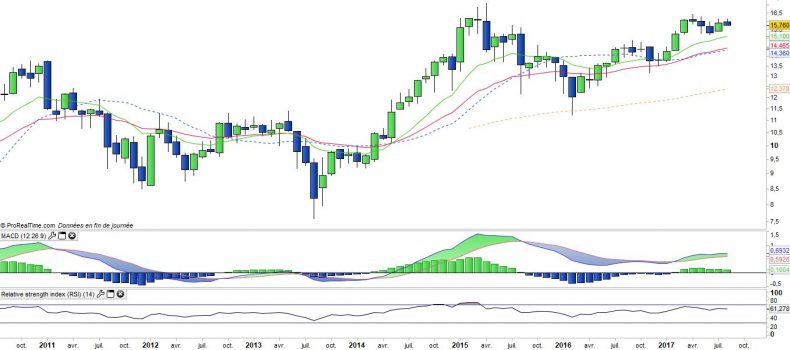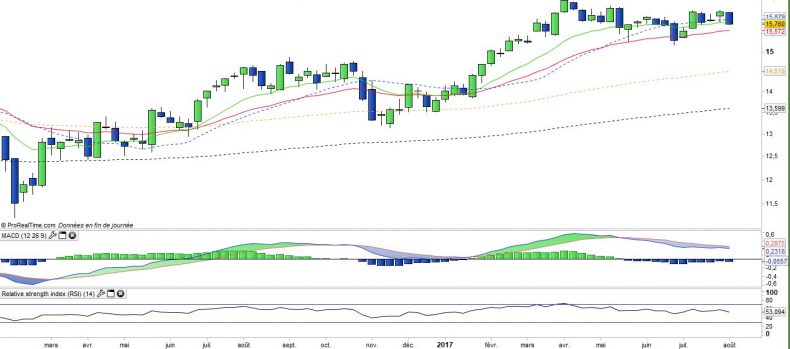Lyxor ETF India - INR - 10/08/2017
Short term strategy : Positive (60%) / Trend +
Long term strategy : Positive (95%) / Trend +
Characteristics of the ETF
The ETF INR (Lyxor) replicates the MSCI EM India Index, which is composed of 77 leading stocks.
In terms of stock market behavior, the Indian index is fairly volatile and posted a slightly positive change in 2016 (+ 0.8%), while the rise in US rates and the strengthening of the dollar weighed on the the second half of the year.
The interest of the INR tracker is two-fold: first, it bets on the most dynamic and promising emerging economy in the world, while the large sectoral diversification ensures a very satisfactory coverage of the Indian economy with a high proportion of growth companies. The important part of the technology sector (14%) - which includes Infosys - in the index, seems to us an asset with regard to the quality of the IT / Software sector in India with leading players. The index is also well balanced in terms of sectors, with 24% for financials, 13% for discretionary consumption, 12% for energy, 10% for materials, 9% for consumer staples and 7% for Health Care, the only particularity being the weakness of the industrial sector.
India, whose GDP is expected to reach $ 2600 billion in 2017 (reaching or even surpassing France in the fifth place in the world), showed better resistance than the other emerging countries to the slowdown in global growth in 2015, compared with Brazil or Russia, to the extent that it benefited from the decline in oil and is not impacted by the fall in raw materials. Growth was strengthened in 2016, reaching 7.6%, making the Indian economy the most dynamic in the world.
Mr Modi is progressing slowly in his reforms, failing a majority in parliament, but is experiencing successes in particular on work flexibility reforms in certain regions and in terms of private investment, in addition an impressive program of dematerialization / has had a negative impact at the end of 2016 and early 2017 but is expected to be positive in the medium term by reducing the underground economy. The Government's program aims to develop the national industry, which is still too narrowly diversified and mainly focused on the textile and chemical sectors; The industrial sector employs 20% of the population and contributes less than 1/3 of the GDP. The service sector is the most dynamic part of the Indian economy and contributes to 52% of GDP by employing about 25% of the working population. The software sector is rapidly expanding and boosting service exports and modernizing the Indian economy.
India is heavily dependent on imports, particularly energy, and benefits from relatively low oil prices. India has begun to catch up on China, with the advantage of being the largest democracy in the world (1.5md of inhabitants) with a positioning on the high-tech sectors. The rise of infrastructure and foreign investment should contribute to the industrial take-off as well as the ambitious tax reforms underway: "the single VAT", which entered into force on 1 July, which aims to harmonize the taxation of a country where, so far, all 29 states have their own regimes, should have a positive impact over time. In the short term, the risk of war with China over the Doklam Plateau issue at the junction of the Indian, Chinese and Bhutanese territories creates a very negative shadow over the country, but this does not seem to frighten the market for the moment.
Expenses are high, at 0.85%, for a high outstanding amount of € 1,400 million.
Monthly data
The analysis of the monthly charts shows that a new upward trend is in progress within a positive long-term trend, despite renewed anxiety on the geopolitical front. All indicators are green, whether they are oscillators such as MACD or RSI, or moving averages 13 & 26 which are ascending. The 2015 peak remains to exceed, currently located on the area of 17 €.
Weekly data
Analysis of the weekly charts shows a steady upward trend along the moving averages 13 & 26, with rather low volatility. The MACD is expected to recover rapidly, following the example of the Momentum and the RSI, which could trigger an acceleration towards the 2015 highs. This bullish crossing should unleash the medium-term bullish potential, freed from all resistance.
ETF Objective
INR is a UCITS compliant ETF that aims to track the benchmark index MSCI Daily TR Net Emerging Markets India.
The MSCI India is a free float market cap-based index wich represents approximatively 85 % of the total market capitalisation in India.
Characteristics
| Inception date | 25/10/2006 |
| Expenses | 0,85% |
| Issuer | Lyxor |
| Benchmark | MSCI Daily TR Net Emerging Markets India |
| Ticker | INR |
| ISIN | FR0010361683 |
| UCITS | Yes |
| EU-SD status | Out of Scope |
| Currency | € |
| Exchange | Euronext Paris |
| Assets Under Management | 1 400 M€ |
| Dividend | Capitalisation |
| PEA | No |
| SRD | Yes |
| Number of Holdings | 77 |
| Risk | 3/5 |
Country Breakdown
| India | 100% |
Sector breakdown
| Financials | 24% |
| Information Technology | 14% |
| Consumer discretionary | 13% |
| Energy | 12% |
| Materials | 10% |
| Consumer Staples | 9% |
| Healthcare | 7% |
| Others | 11% |
Top Ten Holdings
| Housing Development Finance | 9% |
| Reliance Industries | 7% |
| Infosys Ltd | 6% |
| Tata Consultancy | 4% |
| ITC Ltd | 3% |
| Axis Bank | 3% |
| Maruti Suzuki India | 3% |
| Hindustan Unilever | 3% |
| ICICI Bank | 2% |
| Tata Motors | 2% |


